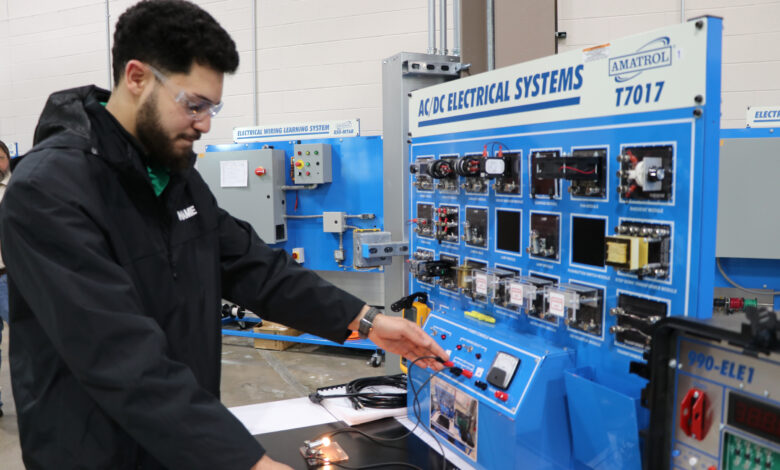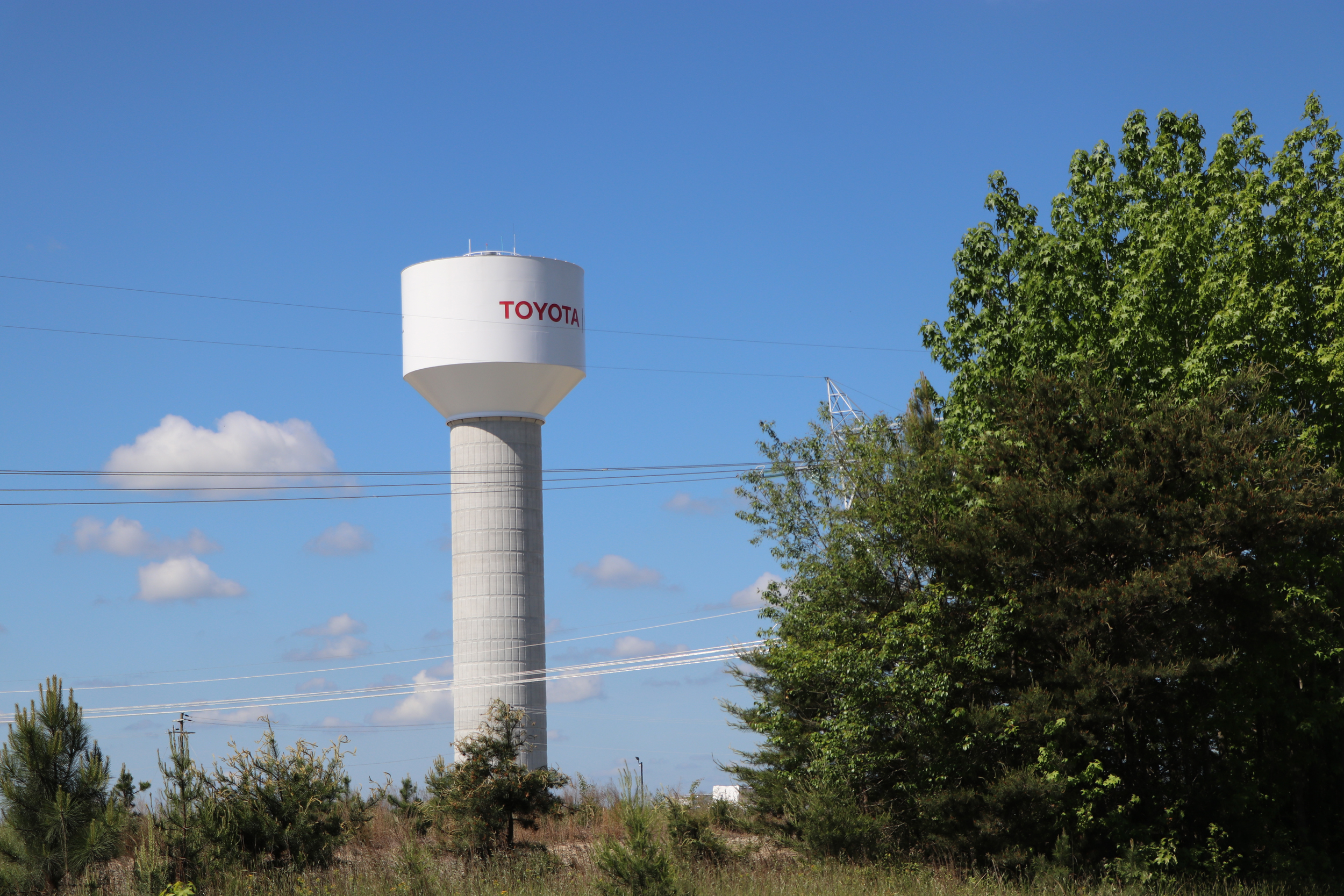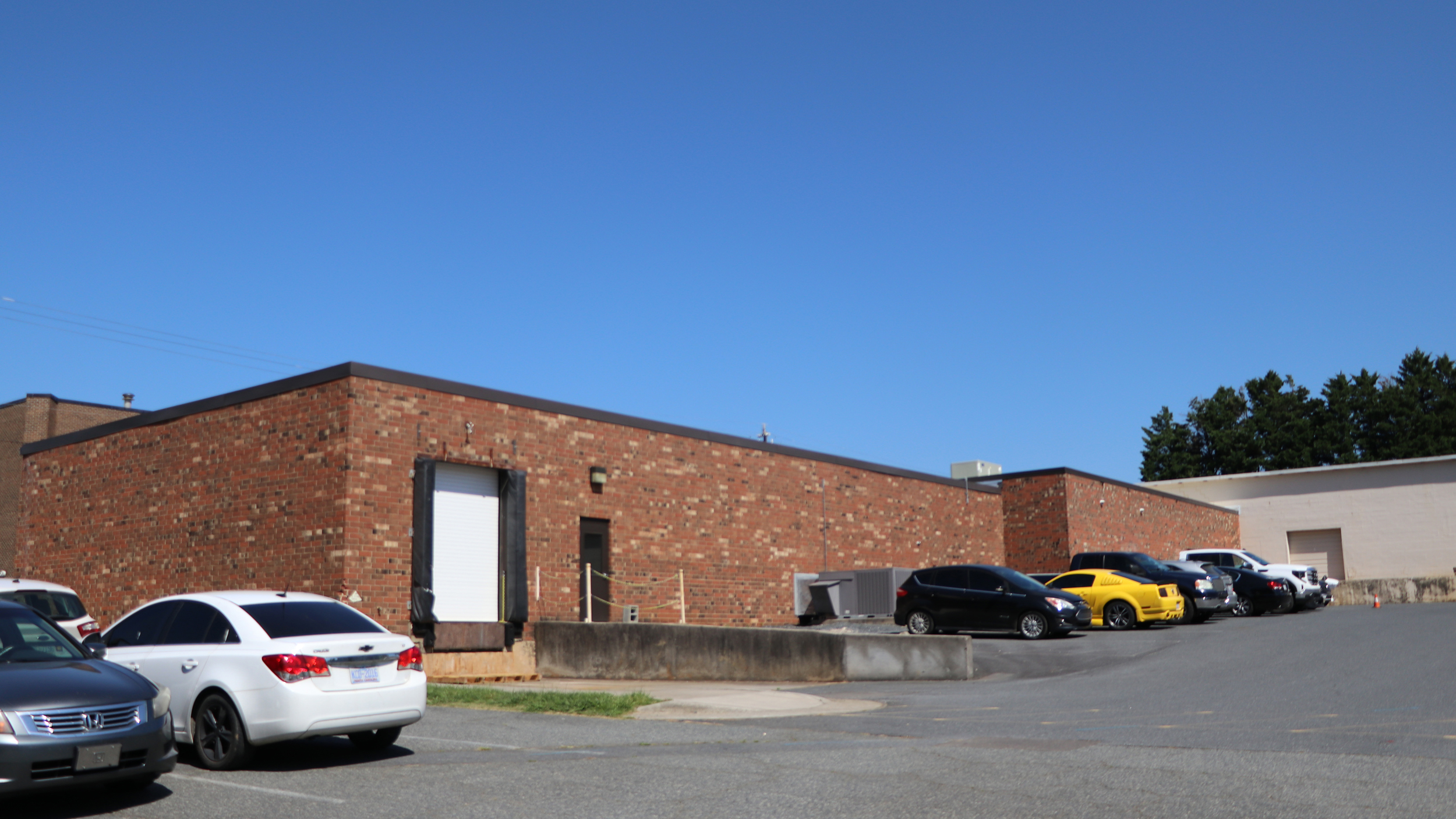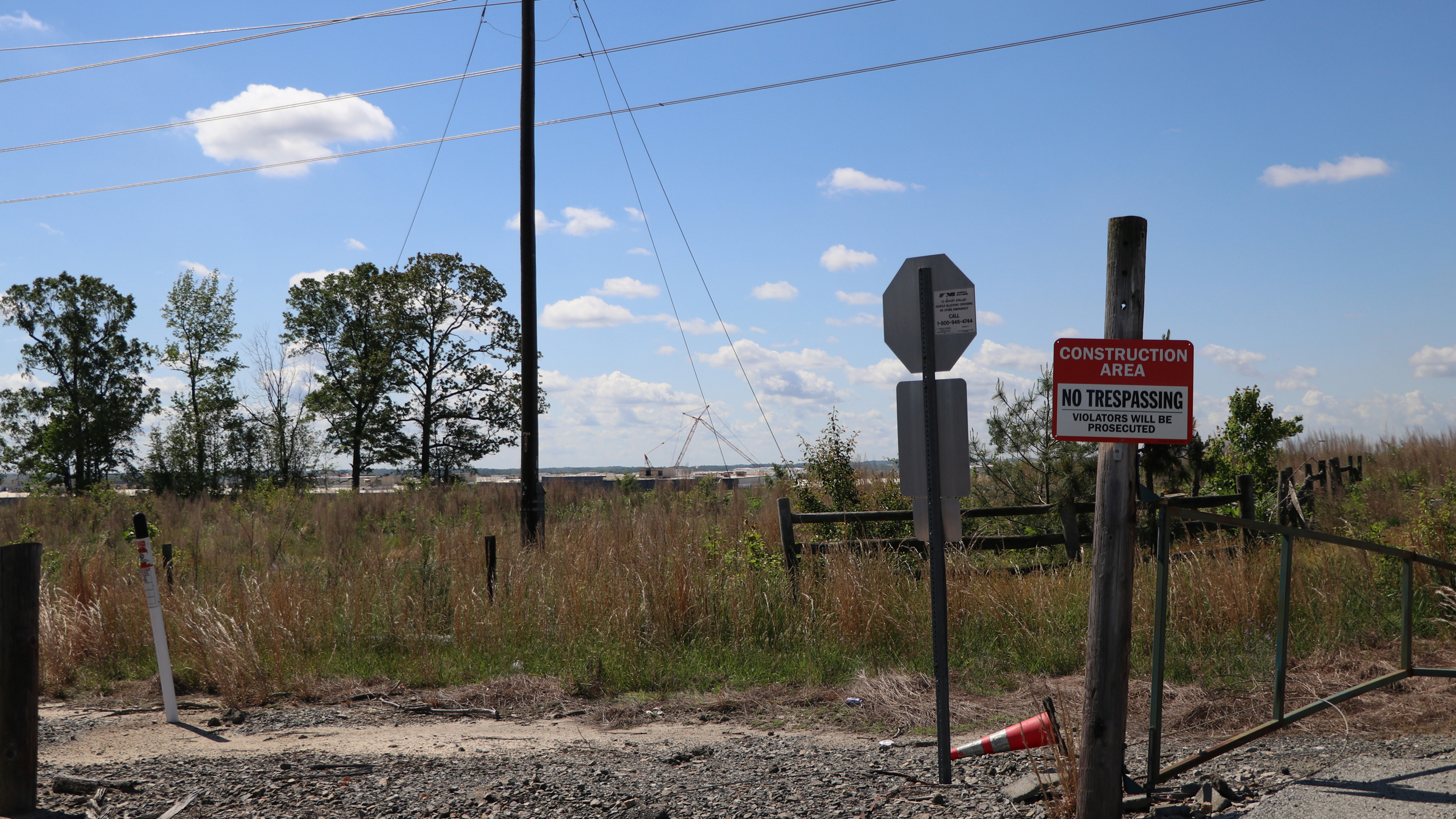Toyota Opens a ‘Megasite’ for EV Batteries in a Struggling N.C. Community, Fueled by Biden’s IRA

GREENSBORO, N.C.— When Muhammud Abu-Kass’ high school teacher told him about an opportunity at a nearby community college to be trained to work for Toyota’s first and only electric vehicle battery plant and get paid for it, he paused his plans to pursue an engineering degree.
“Getting that technical experience is going to be good for the future, as well as working with the company and learning all of these professional behaviors and how to deal with people,” said Abu-Khass, 20.
Abu-Khass joined the first class of a Toyota-founded training program at the Guilford Tech Community College campus in Greensboro, North Carolina. The students’ uniforms, Kelly green polos, stood out against the rows of blue equipment that filled the temporary classroom, a vast space full of high-tech manufacturing machinery.
The job training is part of an economic transformation happening in this mostly rural part of central North Carolina as the growth of electric vehicles and an influx of federal incentives have spurred a level of investment not seen in generations.
Toyota announced in 2021 that its battery plant, with an initial investment of more than $1 billion, would be built in Liberty, North Carolina, about 20 miles southeast of Greensboro. A year later, Congress passed one of President Joe Biden’s signature policies, the Inflation Reduction Act. It included programs to build up the U.S. supply chain for American electric vehicles to compete with Chinese EVs and materials. This prompted Toyota to greatly expand its Liberty battery plant and increase the investment to $13.9 billion.
The incentives outlined by the federal government caused a boom in EV battery and assembly plants across the country and led to companies investing over $110 billion nationwide, according to the White House.
The so-called megasite in North Carolina is projected to bring 5,100 direct jobs and thousands of other indirect jobs to the area, giving new life and opportunity to a once blighted North Carolina region.
Liberty’s Megasite Catches Toyota’s Eye
Beth Pitonzo, senior vice president of Guilford Tech Community College, was asked in 2021 to be a part of a pitch for an unnamed company to relocate to the empty, 1,825-acre megasite in nearby Liberty.
“Pretty soon we found out it was Toyota,” Pitonzo said. “And then people started appearing.”
Toyota representatives soon stopped by her campus to discuss adapting training programs to fit their needs.
“To get into a company like Toyota, right now at the ground floor, wow, I would seize the opportunity,” she said.

North Carolina first tried to lure Toyota to Liberty’s megasite in 2019, when the auto giant was looking for a home for a motor manufacturing plant. After losing out to Alabama, North Carolina tried harder. When it came time to compete for the battery factory in 2021, the state lined up better electricity supply and rail access.
“So then they came back for this big battery project. We were in line and we landed it,” said John Ogburn, a longtime resident and city manager of Asheboro, North Carolina. “This is a global change for us. It’s hard to imagine if you’re not from the southeast, to really understand the dynamics of this project.”
Landing the project brought an influx of skilled jobs to Guilford and Randolph counties, which are about 80 miles west of Raleigh, North Carolina’s capital. Guilford Technical Community College and Randolph Community College seized the opportunity to train students as pre-hires and employees for the plant, which is set to begin production in 2025. Both Liberty and Asheboro are in rural Randolph County; Greensboro, the state’s third largest city, is in Guilford County.
Toyota selected Guilford Technical Community College to house their FAME (Federation for Advanced Manufacturing Education) Program, which the car company founded. During the two-year program, students are sponsored by Toyota and paid to complete long hours in the classroom and hands-on work with Toyota employees at the plant.
Shackti Martinez, a 22-year-old member of the National Guard originally from Honduras, said that she gets to work with an electrical engineer at the plant.
“Besides just teaching, he lets you see what he’s doing,” Martinez said of the engineer. “He’s kind of explaining what’s going on and asking you questions and testing your knowledge seeing if you actually understand and it’s just really helpful.”
Abu-Kass and his classmates, members of the inaugural class at Guilford Technical Community College, worked on a project to improve the service shop at one of Toyota’s Greensboro dealerships and presented their findings to the plant’s president and Greensboro’s mayor.
“When you see that the plant president is actually talking to you and sharing ideas, it was an interesting experience to have coming out of high school,” Abu-Kass said with a proud smile on his face. “It’s like two different worlds.”
Guilford’s FAME program, which enrolled 14 students this year, is expected to double in size next year. The community college pays for the program with help from the state in the form of customized training dollars, a grant from North Carolina’s Department of Commerce.
The community college expects to expand its staff and increase the amount of equipment to meet Toyota’s staffing needs.
Toyota needs thousands of workers, said Pitonzo, “so it’s going to be a job both to make sure we have the number of students, but also the number of faculty that we need to teach them.”
But Guilford Technical Community College’s efforts alone can’t meet Toyota’s demand. Nearby Randolph Community College also added programs to prepare Toyota employees in multiple ways. Students in their Industrial Maintenance Technician Program also get paid and undergo some training at the plant. They also offer “refresher” training to Toyota pre-hires, most of whom will go on to be hired full-time, according Randy Gunter, project manager for Toyota’s customized training program.
Randolph also renovated a space on campus for Toyota to train its full-time employees. Stocked with facilitators and training equipment, the space allows employees to undergo initial training before they work at the plant.
“I’ve never seen anything like this and I’ve been in the industry for 40-plus years,” said Russell Brentnell, a facilitator for the training who works with full-time employees. “This is the first time I’ve seen a company do, to this magnitude, pre-training before anybody ever actually works on equipment. I wish I’d had this 30 years ago.”
Randolph Community College also started training new firefighters for the plant, which will have its own fire station.


‘Generational Wealth’
Toyota’s arrival stands in stark contrast to the area’s economic woes during the 2008 Great Recession. Ogburn recalled gearing up to give a speech at a rotary club when a reporter from the local newspaper ran up to him with some bleak news.
“He asked me, ‘Hey, did you see the Forbes magazine about Asheboro?’” said Ogburn. The magazine had just named Asheboro the fourth fastest dying city in the U.S. Now, Asheboro and the surrounding region have been presented with a chance to revive their economy.
“For the first time in the 250 years of Randolph County’s existence, we have a chance to be wealthy,” said Ogburn. Like many people in the region, Ogburn exuded enthusiasm for his state. He literally wore his North Carolina pride on his sleeve. He wore what looked like a red polka dotted collared shirt, but the polka dots were in the shape of North Carolina.
The state expects about 100,000 people to move to the region. In Asheboro, there will be at least 16,000 direct new jobs within a 30-minute drive, according to Linda Brown, former president of the Asheboro/Randolph Chamber of Commerce.
And they expect thousands more jobs as additional companies relocate because of the Toyota investment. The salaries that these positions offer, said Brown, will be much higher than the region’s average.
“It represents generational wealth to families that haven’t had it before. You know, this has long been a blue collar community,” said Brown, who now works as the strategic planning and development officer at Randolph Community College. “We’ve had a lot of plant closures over the years, and have been through some economic downtimes.”
The influx of people and jobs sparked unanticipated changes for the whole community. To meet housing demands, county and city officials received more zoning and permitting requests than ever before. Hundreds of houses were razed to build a new road to serve the factory.
Those people need new homes, as do the new workers. Neighborhoods already zoned for multifamily use will see much more dense housing. In Liberty, city officials said contractors have planned developments with up to 55 units, much larger than Liberty’s current largest housing development.
The impact will be so large and widespread that even sewage routes must be expanded. While Greensboro will be in charge of providing Toyota with the necessary sewage, the surrounding areas have been encouraged to coordinate with one another on how to best serve the “future intended growth,” according to a city planning document.
Still, some locals preferred their community the way it was.
“A lot of change, it doesn’t come too easy in this part of the world,” said Ogburn.
Many local businesses and manufacturers already lost or anticipate losing employees to Toyota, which can provide high salaries and lifetime employment. But Brown said the Chamber of Commerce has stepped in to help existing employers attract and retain staff.
Toyota also brings in people to the area that will spend money and stimulate the economy. Filmore York, the mayor of Liberty, recalled large tour buses rolling into town carrying loads of people. They’d file into restaurants and shops. He wasn’t sure where they were coming from until he met the president of Toyota North Carolina.
“He said, ‘That’s our employees. We bring him down there to get acclimated and shop in Liberty.’ Now, how good is that?” said York.
North Carolina on the World Stage
This high profile project in the heart of North Carolina has also come to reflect the geopolitical importance of the electric vehicle industry. As the U.S. moves to develop a domestic supply chain, the Biden administration continues to place and raise tariffs on Chinese parts and vehicles.
In May, the administration announced that it would raise existing tariffs on Chinese electric vehicles from 25 percent to 100 percent in 2024. This is in line with Biden’s Investing in America agenda, which includes policies such as incentives to manufacture semiconductors in the U.S., and the Inflation Reduction Act.
“Today’s actions to counter China’s unfair trade practices are carefully targeted at strategic sectors,” said a White House press release. “The same sectors where the United States is making historic investments under President Biden to create and sustain good-paying jobs.”
Last month, the U.S. also rolled out the red carpet for Japanese Prime Minister Fumio Kishida, who was feted with a state dinner and a trip to North Carolina to view the Toyota megasite in-person with North Carolina Gov. Roy Cooper.
Kishida’s visit marked another milestone in Biden’s efforts to counter China, reinforcing the administration’s long term intent to manufacture EVs at home, even if foreign companies benefit from U.S. tax dollars.


Lawmakers stressed the investment was about creating opportunities for Americans.
“This is about American jobs and American production,” said Sen. Debbie Stabenow (D-Mich.).
The megasite is just one of a few dozen battery plants springing up across the nation, particularly in the Southeast’s burgeoning “battery belt.” Companies have invested billions of dollars for battery plants in neighboring Georgia and South Carolina, but the projects don’t rival the $14 billion injected into the Liberty megasite.
The IRA Sparks an Investment Boom
Toyota was a leader in selling gas-electric hybrid vehicles, but has been slow compared to its peers in ramping up production of all-electric models. The Inflation Reduction Act has helped to entice the company to embrace the technology.
The IRA is the United States’ largest-ever investment to combat climate change, with a goal to reduce carbon emissions by 40 percent by 2030. The law has incentives for companies to make batteries and EVs in this country and tax credits for consumers buying EVs that meet requirements based on where they are built and the sources of their battery components.
This story is funded by readers like you.
Our nonprofit newsroom provides award-winning climate coverage free of charge and advertising. We rely on donations from readers like you to keep going. Please donate now to support our work.
The various tax credits add up to a huge advantage in the market for the companies that choose to build their batteries and vehicles in the United States.
Toyota currently offers one fully electric option, the bZ4X. The factory will produce batteries for this model as well as multiple hybrid options.
Change Comes to Liberty
Liberty has already started to feel the manifold local changes spurred by creating these batteries.
A large cement block now sits in front of the theater on West Swannanoa Avenue because big trucks headed to Toyota’s construction site kept bashing into it.
“That’s to keep the trucks from tearing the marquee down because they keep tearing it off because all the cars on the other side won’t back up and let the truck turn,” said York.
As large semi-trucks rumble and maneuver their way through the narrow streets and men in Toyota branded polos and caps roll into the Y’all Come Back Cafe, it is clear that change is already here.


“Back when I was a boy,” York reminisced, “this was a striving little town. It had everything anybody needed.” Since his childhood in the ’50s, he’s only left to go to college and to fight in the Vietnam War.
Though the connection to conflict with China is far from pressing in this sleepy town of 2,600, the Biden administration has made it clear that this investment in the EV supply chain and many others was motivated by the president’s determination to counter China’s dominance on electric vehicles and their components.
Sixty-one percent of announced EV investments have occurred in the last 18 months, since passage of the Inflation Reduction Act, according to the Environmental Defense Fund, creating new opportunities for communities to create jobs and generational wealth.
When York worked for the telephone industry after the war, he could never have imagined that his hometown would be at the forefront of U.S. technology, but he sees the Toyota plant as his legacy.
“We need to be the star, the pinnacle of North Carolina,” he said. “That’s my goal. I got to have a dream.”
Kelsey Baker contributed to this report.



